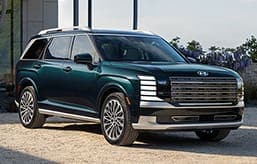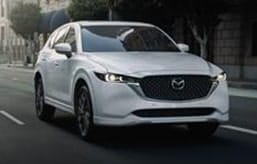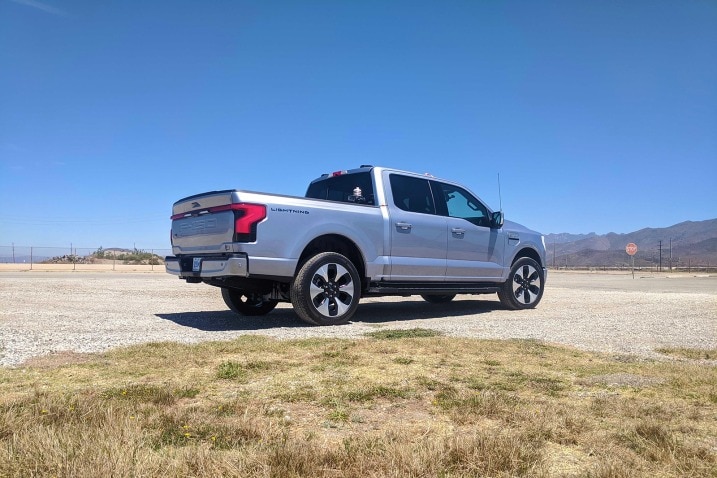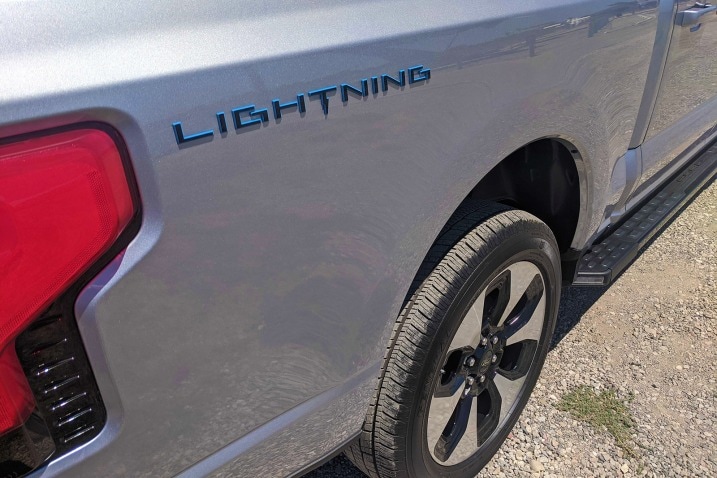- The 2022 Ford F-150 Lightning Platinum beat its EPA range by 32 miles in Edmunds' real-world EV range test.
- Based on our testing, the F-150 Lightning has slightly more range and is also slightly more efficient than the Rivian R1T Launch Edition, which is the opposite of what the EPA numbers predict.
- There are only a few choices for an electric truck at the moment, but the F-150 Lightning is by far the most accessible — as long as it's not the mega-expensive Platinum trim we tested here.
EV RANGE TEST: 2022 Ford F-150 Lightning Takes Down Rivian R1T
The EPA ratings say the opposite, but our real-world test data knows what's up
The extraordinary Rivian R1T has had the electric truck segment to itself for a while now, unless you count the completely mental GMC Hummer EV pickup. But Rivian must be feeling a little less lonely these days. The Ford F-150 Lightning has finally arrived, and so far, we're pretty impressed. While the R1T has a decidedly futuristic vibe, the Lightning looks and drives very much like, well, an F-150, which happens to be Edmunds' reigning Top Rated Truck.
But what kind of range can you really expect to see in an F-150 Lightning? That's what we wanted to find out.
First, we had to pick a version. The F-150 Lightning is available in four trim levels; Pro, XLT, Lariat and Platinum. All Lightnings come with dual electric motors, a SuperCrew body style (Ford's terminology for its largest four-door passenger cabin) and a 5.5-foot bed out back. But the Pro, XLT and Lariat all come standard with a 98-kilowatt-hour battery pack, while a larger 131-kWh battery pack comes standard on the Platinum. We wanted to test the bigger battery, so we went Platinum, but you can also get it as an option on XLT and Lariat.
Am I Ready for an EV?
- EV ownership works best if you can charge (240V) at home or at work
- If you can’t charge at home, charging at a charging station could take at least 10x longer than at a gas station
- Adding a 240V home charging system could cost up to $1,600 or more
The larger battery pack doesn't just come with range benefits, by the way; it also determines the power output of your Lightning. The standard-pack trucks produce 452 horsepower and a massive 775 lb-ft of torque, so no shame there. However, the extended-range battery bumps peak output to 580 hp (the 775 lb-ft remains unchanged). That sort of power scooted our massive Platinum test truck to 60 mph in 4 seconds flat at our test track. Bruh …
But we're focusing on range here. The EPA projects a range of 300 miles for the Platinum F-150 (320 miles for the XLT and Lariat models with the larger battery pack), which is right there with the Rivian's official 314-mile estimate. Now, we've already seen the Rivian validate its EPA range estimate, albeit by a hair. Would the electron-juiced F-150 follow suit? Would it ever!
Testing the F-150 Lightning in the real world
Edmunds tests every new electric vehicle on the same real-world driving loop to see just how far it can travel from a full charge down to zero miles remaining. If you scroll through our EV range leaderboard, you'll see that most EVs have matched or exceeded their EPA range estimates in our testing. Much of that has to do with our ability to test in near-ideal conditions year-round.
Our top-shelf 2022 F-150 Lightning Platinum ($93,509 as tested, although the 2022s are sold out and a comparable 2023 will run you $99,609) automatically checks just about every option box available, in addition to having the larger battery pack as standard. The only two options on our window sticker were the Max Recline seats and the bedliner. While we don't doubt the additional equipment and luxuries in the Platinum tack on some weight, we suspect the larger 22-inch wheels and tires are to blame for the EPA's lower range and efficiency estimates compared to those for the XLT and Lariat.
On test day, we inflated those pizza-tray-sized wheels to the factory-recommended pressures of 42 psi and rolled the Lightning onto the scales, recording an official weight of 6,871 pounds. In case it's not obvious, that's heavy. It's nearly 1,100 pounds more than what the Edmunds' long-term F-150 Hybrid weighed in at, although still lighter that our dimensionally smaller Rivian R1T Launch Edition, which tipped the scales at 7,069 pounds — carrying a total of four electric motors will do that to a truck.
We spent many hours at the helm our 2022 Lightning with a slightly sweaty upper lip thanks to an average ambient temperature of 81 degrees (that's hot for us), and in the end we'd logged a total of 332 GPS-verified miles, about 10 miles more than what we saw on the Lightning's onboard trip meter. That's a whopping 32 miles more than the EPA estimate, netting out to a 10.7% improvement.
Remarkably, the Lightning's 332-mile performance pips both of the Launch Edition Rivian R1Ts we've tested, the first at 317 miles on 21-inch wheels and the second (our long-term test truck) at 323 miles on its 20-inch wheels with all-terrain tires. That's right — an F-150 stuffed with battery cells just took down the Rivian R1T. Well played, Ford. Well played.
So how much did those 332 miles cost?
While the total range of a vehicle continues to dominate the EV conversation, energy consumption is an important factor as well, especially when it comes to larger electric vehicles such as the Lightning. Energy consumption is what determines how much your miles will cost you. The unit of measurement for consumption, the kilowatt-hour, can be thought of as the EV equivalent of a gallon of gasoline. Just like gas, the price of electricity varies depending on where you live. For example, you'll pay about 11 cents per kWh in Washington as of this writing, whereas in Hawaii it'll run you about 44 cents.
So, what can Ford owners expect to pay at "the pump"? After charging the battery back to full, we calculated an Edmunds consumption rate of 45.4 kWh/100 miles, which is 11% more efficient than the EPA estimate of 51 kWh/100 miles and also slightly more efficient than both of the Rivian R1Ts we've tested, which averaged 47 kWh/100. Based on that 45.4-kWh/100-mile consumption rate, if we lived in Hawaii, our 332-mile trip would have cost us $66.32, while if we lived in Washington, that same trip would have cost just $16.58.
If we compare the Lightning to the R1T, the same 332 miles in the Rivian would have cost a negligible amount more at $68.66 in Hawaii and $17.16 in Washington. It's worth noting that saying the Ford is more efficient than the Rivian is faint praise indeed, as the R1T is straight up the least efficient EV we've tested to date. But hey, the Lightning's not dead last, so there's that.
How about a gasoline-powered equivalent? Though they don't really compare in power or price, Ford does sell a Platinum F-150 SuperCrew with a 5.0-liter V8 under the hood. The gas-powered Platinum (which can also run on e85) starts at an MSRP of about $63K, so about two-thirds the cost of its fully electric counterpart. Its 5.0-liter V8 engine produces a decent 400 horsepower but offers little more than half the torque of the Lightning at 410 lb-ft. The good news is that the V8 isn't picky about its octane, so regular fuel is fine, and this F-150 is estimated to get 20 mpg in combined driving. That's not bad for a V8 behemoth. Assuming we got 20 mpg driving it for 332 miles, it would have cost us about 25% more in Hawaii ($87.98 at $5.30 per gallon) and more than four and a half times more in Washington ($77.36 at $4.66 per gallon) based on current gas prices.
Accordingly, you could save an estimated $652 per year in Hawaii and about $1,830 per year in Washington by driving an electric Platinum F-150 for 10,000 miles instead of the V8-powered Platinum F-150. With that said, if you're planning to buy the Platinum Lightning for cost-saving purposes, just know that it would take you 20 years to make up the purchase price difference if you lived in Washington, and about 57 years in Hawaii, averaging 10,000 miles a year. And this doesn't even take into account the higher cost of public fast charging. In short, you better have another strategy for convincing the family council that a Platinum Lightning purchase makes sense.
For more information on how we test EV range and how each vehicle performed, we invite you to visit our Real World vs. EPA testing page, which includes both our EV range leaderboard and a table with detailed test results. Our EV range leaderboard is embeddable and will automatically update every time we add a new vehicle.
Edmunds says
The 2022 Ford F-150 Lightning proved, just as Ford's Mustang Mach-E has many times over, that it can hit its range numbers without issue. Furthermore, it took down the fancy-pants Rivian R1T in both range and efficiency, although to be fair, the Platinum Lightning is pretty fancy-pants itself. At least you can theoretically buy an F-150 Lightning for much less than the Platinum's price, a move toward electric-truck affordability that we hope becomes a trend. We're looking forward to testing more Lightning models in the near future to see how much our results change when we step down the price ladder. For our latest comprehensive ratings of all electric vehicles, head over to Edmunds' EV rankings page.







 by
by